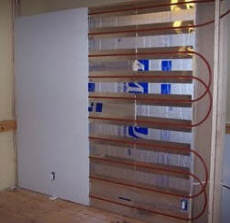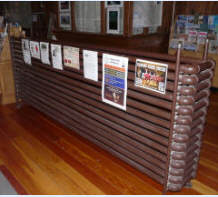
Search
The Renewable Energy site for Do-It-Yourselfers
$2K Solar Space + Water:
Radiant Floor Design
This section goes through the design of a DIY heat distribution system
that will distribute the heat your solar collectors produce to the
house.
| Our system uses a radiant floor system,
which is a very efficient system for distributing heat from
solar heating systems.
Quite a few alternatives to radiant floor are also
discussed.
Back to Table of
Contents... |
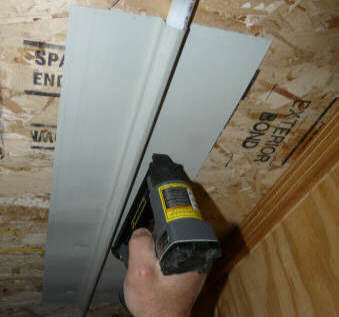 |
The Construction Section - Staple-Up
Radiant Floor Heating describes the physical installation of our
radiant floor system. |
|
Guidelines for Solar Heat
Distribution Systems
A couple things to bear in mind for systems
to distribute heat from solar systems:
Try to choose a system that will heat with not so hot water:
Solar collectors will operate more
efficiently if they are producing producing lower temperature hot
water. That is, they are better at producing a lot of fairly hot water
than they are at producing a little very hot water. This means that a
heat distribution system that can make use of water at moderate
temperatures is better than one that needs high temperature water.
For example, radiant floor heat can use water all the way down to about
80F to produce heat, while traditional radiators want water up at 160F.
A solar system that is asked to produce 160F water is not going to be
very efficient.
We used a simple, staple up radiant
floor heating system to distribute the heat for our system.
Because our system is relatively small and can produce only a limited
amount of heat, the floor system is very simple consisting of only one
200 ft loop of PEX -- its also very cheap.
Radiant floor heating is not the only
choice -- the Alternative section below lists several good and simple
methods for distributing solar heat.
Just concentrate on
distributing the solar heat:
Another important thing to bear in mind
is that in most cases you can just concentrate on a system that is sized
to deliver the most solar heat that the collectors can gather in a day
to the house over that day. This is usually requires a lot less
hardware than a heat distribution system that has to meet the full heat
demand of the house on the coldest day of the year.
The reason this works is that most
people will retain the existing heating system in addition to the new
solar heating system. This means that all the solar heat
distribution system has to be able to handle is the most heat that the
solar collectors can produce in a day, and because the solar storage
tank usually stores a full day of solar heat, the distribution system
has all day to distribute this heat to the house.
But, also see the notes below and here for the situation in which the solar system is the only heating system and must provide all of the heat and include a backup heater for non-sunny weather.
Sizing Guide
In sizing the heat distribution system, it
is probably fairly safe to say that your solar system on a sunny day can
deliver about 800 BTU/sqft of collector area. So, if you have a total
collector area of (say) 200 sqft, and you estimate that the domestic hot
water uses the output from about 50 sqft of that, then then the maximum
solar heat output of the system for a sunny day going to space heating would be about (150 sqft)(800
BTU/sqft) = 120,000 BTU for the day. The heat distribution system
should be able to distribute this much heat to the house over a full day.
How much heat your floor loop can
transfer to the house depends on the length of the loop, the temperature of the water you are
circulating, and on the R value of the floor and floor covering between the
PEX floor loop tube and the room, and also on whether you are using heat
spreader plates.
This is a handy plot form the
Warmboard Website
that shows the relationship between heat output needed, the temperature of
the water you circulate to the floor, and the R value of the floor covering.
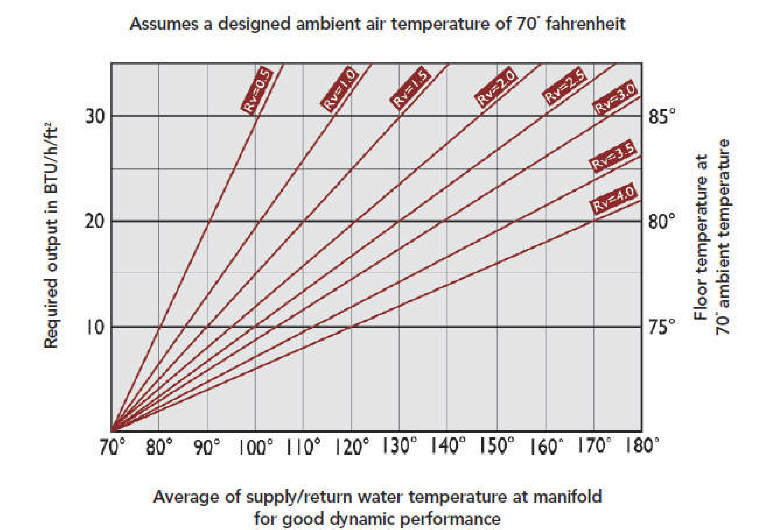 The plot lets you estimate how much heat a
given size floor can distribute to the house based on the R value of your
floor covering and the average water temperature you want to circulate to
the floor.
For example:
The plot lets you estimate how much heat a
given size floor can distribute to the house based on the R value of your
floor covering and the average water temperature you want to circulate to
the floor.
For example:
Assume:
- We need to distribute 120,000 BTU
from the storage tank to the house (as per the example above).
- 900 sqft of radiant floor heated
area.
- R value for your floor covering is R1
- Target an average of 85F for the
circulated water (to keep the solar collectors operating efficiently)
- That the system can operate up to 20
hours a day to distribute the 120,000 BTU in the storage tank.
Reading off the plot where 85F water supply
and R1 floors lines cross gives a heat output of about 10 BTU per hour per sqft of floor.
So, the Heat Output of the floor for the
day = (10 BTU/sqft-hr)(900 sqft)(20 hours) = 180,000 BTU per day
So, the system makes the 120,000 BTU per day with quite a bit of margin in
hand.
Given that this is a Warmboard plot, and
Warmboard is very much on the efficient end of radiant floor heat delivery
systems, it is good to have some extra margin over the needed 120,000 BTU
per day if you are using a less efficient system.
Bear in mind that this is just a rough way
of estimating the amount of floor loop needed -- you can probably find
methods that more exactly match the actual type of radiant heat loops you
plan to put in.
Alternative Heat Distribution
There are other ways to distribute heat to
the house from the solar system.
Larger radiant floor
If you have a larger solar collector
for space heating than we do (a good idea), then you may need more than
one radiant floor loop to distribute the heat to the house. Our
Solar Shed project, which has 240 sqft of collector has 5 floor loops
that are fed from a manifold -- it is
described here.... -- look in the section on heat distribution to
the house.
There are also several other example
systems that use
larger radiant floor systems in this section...
|
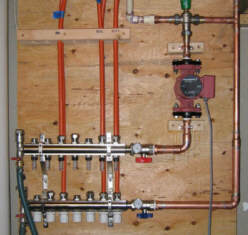 |
Hydronic baseboard
Regular hydronic baseboard units can be
used to distribute solar heat to the house. Although these units
are generally intended for higher temperature water that solar systems
typically deliver, they still deliver significant heat at lower
temperatures.
This table from SlantFin gives the
heat output per foot of radiator for various water temperatures...
The table goes down to 110F water, and you can extrapolate to even lower
temperatures.
As an example, 20 ft of the SlantFin
hydronic baseboard in the table operating on 110F solar heated water
could deliver (160 BTU/ft)(20ft)(24 hr) = 77,000 BTU over a full day.
|
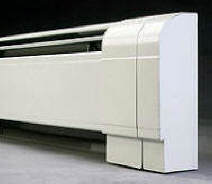 |
- Coil in furnace duct
A heat exchanger coil can be placed in your forced air furnace duct to
add add heat to the house duct system. The regular furnace fan can
be used to circulate air through the duct system and pick up heat from
the heat exchanger coil.
Here is one
company that supplies this type of heat exchanger...
In picking the size of coil required be
sure to adjust coil heat output for the fact that you will be using
cooler hot water than the coils are nominally rated for -- most
suppliers will provide a factor to multiply the heat output by if cooler
water is being used.
|
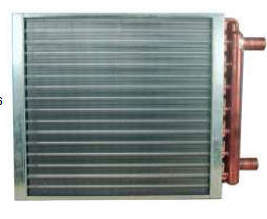 |
- Car radiator
While it may not seem like the most elegant approach, car radiators are
very effective water to air heat exchangers, and they even come with a
fan to move the air through the radiator. If you don't care for
the looks of a car radiator in your living room, it can be placed in a
nice looking cover.
|
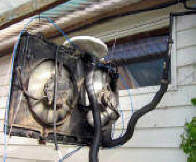 |
- Uncover the tank
One very simple way to distribute the solar heat to the house if the
tank is located in a heated area of the house would be to just have a
way to take the insulation off the tank when you want to use the heat.
The tank will then lose heat to the room.
A rough calculation says that a tank with 100 sqft of heat transfer area
in the form of non-insulated walls and top with 110F water could
transfer about 3300 BTU/hr to a 70F room with a heat transfer
coefficient of 1.0 BTU/sqft-F, which should be pretty close to free
convection. This would 80,000 BTU in a day. This could be
increased substantially with a low power fan blowing over the tank --
maybe a slow ceiling fan above it.
If you plan to use this method, it would be good to build the tank in a
shape that has more surface area for the enclosed volume than a cube --
for example a tank that is relatively thin in one direction. You
would also want to leave out the inside insulation and make it easy to
remove the outside insulation.
- Direct to slab distribution
One method that I believe would work is
to have the solar collectors distribute their heat directly to the
concrete slab of the house floor. I have heard from several people
who were planning to do this, but have not heard back on how well it
worked out.
This could be done with a small drain
back tank which would just be a few gallons to store the driained back
collector fluid, and provide a place to pump fluid out to the slab.
Or, if one wanted no tank at all, a closed loop system with antifreeze
could be used to just pump heated antifreeze from the collector out
through the floor loop, and then right back out to the collectors.
In this arrangement, the thermal mass of the slab is the heat storage.
This would not work well unless there was insulation under the slab.
Backup Heating
Our system was initially sized per the groundrules above to only be able to deliver the heat that the solar collectors could provide over a sunny day. But, last winter the gas furnace that provided our backupheat died, and rather than replacing it we decided to add a backup heating capability to the solar system. The new backup heater is an electric water heater with a pump to circulate water from the electric water heater into the main solar tank when there is not enough sun to keep the main solar tank warm enough for space heating. The backup heating system is dtailed here...
Having the solar system as the only heating system also changes the ground rules for the radiant floor, as it now must be able to deliver the design heat load to the house, whereas before it only had to deliver what the collectors could produce on a sunny day.
The best place to start for this kind of design would be to do a heat loss calculation for the part of the house you plan to heat exclusively with the solar system. Once you know the design heat loss, you can use the same radiant floor design chart above to size the radiant floor to deliver the design heat load. The backup heat source should also be designed to be able to deliver an amount equivalent to the design heat loss. From my knothole, I would not get overly conservative in these calculations -- days that get down to the design low temperatures are rare. It is also a good time to think about making improvements to insulation, sealing, windows,... to reduce the design heat load.
References
The Build-It-Solar section on heat
distribution for solar systems...
The Radiant Floor Company has several
schemes for implementing radiant floor heat.
http://www.radiantcompany.com/details/
Radiant Floor Company manual provides a lot of useful information...
Gary February 20, 2011, December 21, 2013




